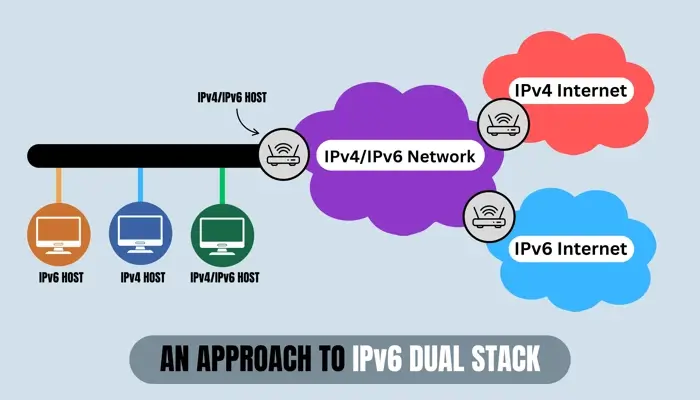What Is IPv6 Dual Stack?
The Internet is moving from the familiar IPv4 address format to the vastly more expansive IPv6. But IPv4 and IPv6 will coexist for a long time, making the transition to IPv6 a complex, gradual process. IPv6 dual stack networking allows IPv4 and IPv6 to operate side by side. In this article, learn what IP version 6 dual stack is and what it means for your network.
What is IPv6 dual stack?
IPv6 dual stack refers to a network configuration allowing devices and networks to support IPv4 and IPv6 protocols simultaneously. Because the devices have both IPv4 and IPv6 addresses, they can communicate using either protocol.
As the Internet expanded, more network address translation devices switched to IPv6 instead of IPv4. This shift poses a challenge for service providers because they can’t keep giving customers globally accessible IPv4 addresses, but can't have new routable IPv4 addresses to expand their networks either. Simply switching to IPv6 alone isn’t enough though. In other words, IPv4 and IPv6 will coexist for a long time.
Many parts of the public Internet, including websites, services, and user devices, are still set up to work only with IPv4. Broadband service providers, like DSL, cable, and mobile, still need a compatible solution that accommodates IPv4 customers.
To manage this, Internet service providers have chosen an IPv6 dual stack. This simple IP address transition solution involves both protocols in parallel in a dual-stack configuration. In a dual-stack network, each device is configured with IPv4 and IPv6 connectivity.
Dual stack makes both network families active. Devices can communicate over IPv4 or IPv6 as needed. That means you’ll browse the web without worrying if the change in IP address systems will disrupt your connection.
Other strategies, such as tunneling, exist. But for now, dual stack is the most workable solution in many scenarios. New transition techniques are still developing as organizations seek to operate a single protocol, IPv6-only environment.

Architecture of IPv6 dual stack
Dual stack technology is driven by DNS. In the dual-stack setup, each device is assigned two IP addresses: one IPv4 address and one IPv6 address. When a device needs to connect to another, it first determines which IP version is available on the destination device.
If both IP formats are supported, IPv6 is usually preferred due to its larger address space and improved features. However, if only IPv4 is available on the other end, the system will automatically use the IPv4 protocol to suit older system connectivity needs.
Network devices within a dual stack architecture are typically configured to prioritize IPv6 but fall back to IPv4 as needed. This allows services that are IPv4-only to continue functioning without disruption while IPv6 is progressively implemented.
A key component in dual-stack networks is that routing tables, domain name system (DNS) servers, and firewall settings must support both address types. This way, DNS can resolve domain names to IPv4 or IPv6 addresses. Firewalls manage traffic based on both protocols.
Dual-stack architecture minimizes the need for complex translation mechanisms between the two IP addresses by supporting both protocols natively.
This approach reduces latency, avoids compatibility issues, and simplifies the transition. It enables organizations to gradually shift to IPv6 without a sudden overhaul of their infrastructure. Due to IP incompatibility, end-users experience a seamless browsing experience.
Benefits of using IPv6 dual stack
Dual stack IPv6 offers numerous benefits to users and their devices. They include:
- Ensuring compatibility and interoperability. The best part about dual stack is that it keeps the network compatible with both IP version 4 and IP version 6 devices. This allows for smooth communication between older and newer systems.
- Gradual transition to IPv6. Switching everything to IPv6 right away would be very hard. Dual stack allows for a gradual switch, so organizations don’t have to do everything at once. They can update their systems over time to reduce the risk of something going wrong.
- Improved network performance and security. IPv6 has features that improve network performance, like automatic device configuration. IPv6 also has better security features. In a typical case, dual-stack networks strengthen security without causing interruptions.
Challenges and limitations of IPv6 dual stack
Unfortunately, IPv6 dual stack isn't a perfect solution. Complexity, costs, and security risks pose potential challenges when implementing the networking approach:
- Increased complexity in network management. Managing a dual stack network is more complicated than handling just IPv4 or IPv6. Network administrators must keep track of two sets of addresses, making troubleshooting more difficult.
- Higher resource and cost requirements. Running two protocols simultaneously can require more resources, like better hardware and new software updates. There are also extra costs in training network administrators to understand both protocols.
- Potential security risks. An IPv6 dual stack needs to be secured for both IP address types. This means more work to ensure that neither protocol has vulnerabilities that hackers can exploit.
IPv6 dual stack deployment strategies
As ISPs and network technicians figure out the best way to deploy dual stack, there are several strategies that are commonly used.
Phased deployment approach
One common way to deploy dual stack is in phases, starting with certain parts of the network and gradually moving on. For example, a company might start with internal servers and eventually add a dual stack to public-facing websites. This gradual approach offers time for troubleshooting any issues.
Service provider considerations
Internet service providers face special challenges when adopting dual stack. They must ensure that both IPv4 customers can use their networks without wondering if the connection will stop working because of the IP address conversion. Many ISPs implement dual stack to support customers as they move to IPv6.
Cloud and data center deployment
A dual stack is ideal for cloud providers and data centers because they need to support clients with both IP addresses. In these environments, dual stack guarantees future compatibility as more devices use IPv6.
Case studies and real-world examples
We see IPv6 dual stack in many real-world situations. Many large companies have already started using dual stack to support both IPv4 and IPv6.
For example, major corporations use dual stack internally to improve communication between their servers and then extend this support to public-facing systems. The lessons learned from these cases include the importance of planning.
Some ISPs, like Comcast and Verizon, have implemented dual stack to serve IPv4-IPv6 customers. This allows them to support all customers without forcing anyone to change right away. These ISPs have shown that dual stack can be used effectively even on a large scale.
Additionally, some governments have encouraged or even required IPv6 adoption. Government agencies use a dual stack to continue using IPv4 while preparing for the switch to IPv6. These initiatives push more organizations to adopt IPv6, ensuring smoother communication worldwide.
Future of dual stack
Eventually, we’ll reach a point where most networks will be IPv6-only. Experts predict that as IPv6 adoption grows, we’ll be able to phase out IPv4 completely. This will simplify networks since only one protocol will need to be managed. But it will take time to reach this stage.
IPv6 dual stack has proven to keep everything connected, mainly as new technologies like the Internet of Things (IoT) and 5G rely on IPv6.
Frequently asked questions
What is the difference between IPv4 and IPv6?
IPv4 uses 32-bit addresses, while IPv6 uses 128-bit addresses, allowing vastly more unique IPs.
How do I configure my router for IPv6 dual stack?
Access router settings, enable IPv6 in WAN settings, and select "Dual Stack" mode. Consult your router’s manual for specific instructions.
What is dual stack in IP version 6?
Dual stack IPv6 is the network approach that allows devices and networks to support both IPv6 and IPv4 simultaneously.
Can I run IPv4 and IPv6 simultaneously on the same network?
Yes, with a dual stack setup, IPv4 and IPv6 can operate concurrently.
Is IPv6 dual stack compatible with all devices?
No, only devices with IP version 6-capable hardware and software support dual stack. Older devices may lack IPv6 compatibility.

